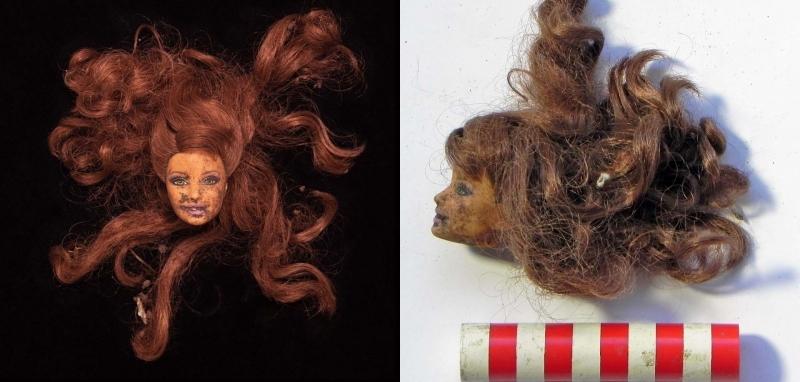Toys, tins and tear gas: recording objects from the Calais ‘Jungle’
Post-Excavation Manger, Louise Fowler, has been working on an assessment for the Dzhangal Archaeology Project with MOLA colleagues and Sarah Mallet, a TORCH Knowledge Exchange Fellow based at the School of Archaeology at the University of Oxford and researcher for Pitt Rivers Museum's LANDE exhibition. Together they have been recording a group of objects collected by the photographer Gideon Mendel at the site of the Calais ‘Jungle’ camp, many of which were displayed in 2017 as part of his exhibition Dzhangal at the Autograph ABP gallery in London. In this blog she shares some of her personal observations, thoughts and hopes for the project.
I open a plastic Ziploc bag and reach in carefully to take out a tiny smiling toy head almost entirely engulfed by long, unruly locks of chestnut hair. I have seen her before. In Gideon’s dramatically staged photograph she looks like the head of Medusa, with coils of snake-like hair.
Her detached head makes me think of other kinds of detachments – the kind you might feel if you were far from the place where you were raised, or the place that you thought of as home.
She also makes me think of the children who were living in the place where she was found. The streaks of dirt on her face make me think of the daily difficulties of life in such a place.

But in spite of these thoughts, I also want to know her ‘real’ story. Where does she come from? Who owned her? How did she come to be here in my office? To ask these questions makes me feel more like a border guard than an archaeologist, as though I am questioning her right to be here making me feel things.
I wonder whether these are the right questions to be asking. I already know that contrary to many accounts of the ‘Jungle’ that appeared in British newspapers during 2016 there were children living in the camp: in August of that year there were 865 children recorded in the census carried out by the charity Help Refugees, of whom 78% were unaccompanied. This doll might have belonged to a child refugee, or she may not have done. In Calais during the summer of 2016 more toys were being donated for displaced children than were needed, and there’s no evidence on this doll for me to be able to tell either way.
If archaeology isn’t useful here to reconstruct a history of the ‘Jungle’, what can we contribute? So far, we have photographed and recorded over 1,200 objects, from rusted tin cans and burnt pallets to cooking equipment, tear gas canisters, tents, toys and clothing. Among the objects there are things that connect us: clothes and toys with labels from British shops, French tear gas canisters, and rusty tin cans with labels from British supermarkets. An archaeological understanding of these objects must look for context far beyond the boundaries of the camp: in the global flows of people, money and goods; in the responses of our national governments and of the EU, and in the actions of displaced people, citizens, charities, activists and artists who used all of their available resources to continue to live, to try to make the best of things, and to draw attention to an intolerable situation.
This project is also a pressing reminder that the history of archaeology is deeply entwined with the history of nation-states. Prehistoric and later finds have been used to make claims to areas of land and to extend the sovereignty of nations back through time, rooting them more deeply into the landscape, and making the borders that we impose to divide ourselves appear inevitable and unchanging. It is still a very current issue – The Telegraph recently published an article claiming new discoveries from Stonehenge demonstrated that ‘British identity’ began 5,000 years ago with a ‘Neolithic Brexit’.
Our work with this collection recognises that on the contrary, within the territories controlled by nation-states are people who don’t fall easily into the category of citizen but who are nonetheless living their lives, though some might prefer to ignore or overlook them. Since its residents were evicted in October 2016, the authorities have worked to erase the camp’s traces, and the site is now a nature reserve for migratory birds. But 1,000–2,000 displaced people still live in the area around Calais. They are repeatedly woken, evicted and moved on by the French authorities, and their right to a piece of ground big enough to exist on is under threat. I hope that our work will go some way towards helping to recognise, at the least, their presence.